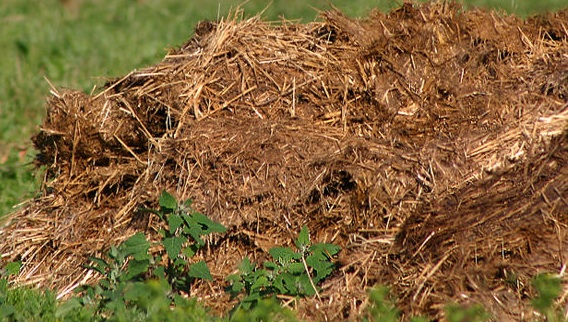
News
Budgeting for P, N with manure applications
January 24, 2011 by Organic Agriculture Centre of Canada
 January
January
17, 2011 – One of the major challenges facing the growing numbers of organic
farmers is the ability to efficiently meet the fertility needs of crops without
the use of conventional fertilizers.
Typically, in addition to green manures and approved amendments, organic
operators utilize animal manure to fulfill a crop's nutritional requirements. Researchers are discovering, however,
that not all manure is created equally.
Numerous variables, including animal and manure type and environmental
conditions, interact in often unpredictable ways to influence the final
product's unique ability to supply nitrogen and phosphorous.
January
17, 2011 – One of the major challenges facing the growing numbers of organic
farmers is the ability to efficiently meet the fertility needs of crops without
the use of conventional fertilizers.
Typically, in addition to green manures and approved amendments, organic
operators utilize animal manure to fulfill a crop's nutritional requirements. Researchers are discovering, however,
that not all manure is created equally.
Numerous variables, including animal and manure type and environmental
conditions, interact in often unpredictable ways to influence the final
product's unique ability to supply nitrogen and phosphorous.
“It’s
a complicated system,” agreed Jim Miller during a recent phone interview.
“That’s how the natural world works.”
 |
|
Miller,
a research scientist with Agriculture and Agri-Food Canada, has spent an
impressive amount of time studying these elaborate interactions. Over a
nine-year period, he and fellow researchers in Lethbridge, Alberta, have
monitored soil nitrogen and phosphorous levels in a barley field annually
amended with several combinations of manure and bedding at three increasing
application rates of 13, 39 and 77 Mg per ha. Their results, entitled:
Available nitrogen and phosphorous in soil amended with fresh or composted
cattle manure containing straw or wood-chip bedding, are published in the
Canadian Journal of Soil Science.
In
terms of nitrogen release, “straw [bedding] is definitely better than wood
[chips]” when present in either fresh or composted manure at all three
applications rates.
Soils
amended with straw bedded fresh manure exhibited the largest soil nitrate
concentrations. Although the
nitrate form of nitrogen is vital for plant growth, there is always the
potential for its accumulation to levels that exceed what is recommended. In
fact, in 2004, nitrate levels in the soils amended at the highest application
rate with the fresh manure, straw bedding combination were more than 15 times
greater than the limits set out by the Alberta provincial government.
The
consequences of excessive nitrate levels include nitrate leaching to
groundwater sources. In addition, soil nitrates also have the potential to
convert to nitrous oxide, a known greenhouse gas.
In
contrast to nitrogen, the study established that phosphorous release was
similar for fresh and composted manure bedded with either straw or wood chips.
Like nitrogen, however, phosphorus will continue to accumulate in the soil with
increasing application rates. The study found that after only two years of
application at the higher rate, soil available phosphorus exceeded the maximum
agronomic threshold for phosphorus as set out by the Alberta government by
nearly twenty times. The concern in this instance is the potential runoff of
phosphorous to surface waters. Phosphorus runoff has been linked to the
eutrophication of oceans, lakes and streams.
So,
what's a farmer to do?
From
an agronomic perspective, “you need to decide what your objective is,” points
out Jim.
For
a farmer that likely means identifying existing soil nutrients as well as the
crop’s agronomic needs. In other words, “there is an increased need for soil
budgeting rather than simple soil tests,” says Jim. A nutrient management plan
indicates the nutrient requirements of each crop. In the study, manure
application rates were the same, year after year, with no accounting for
nutrient requirements. The result was excessive nutrient levels in relatively
short periods of time.
The
study also suggests it is preferable that organic operators apply any of the
manure-bedding combinations based on a phosphorus budget rather than on a
nitrogen budget. A budget based on meeting crop phosphorus needs with manure
may result in an N deficit, but legumes in rotation can make this up. A budget
based on providing all N for crops with manure will inevitably lead to soil
phosphorus excesses.
Jim
also points out that farmers may have other objectives when considering the
right manure bedding mix. Several studies have concluded that bedding mixtures
that utilize wood chips will keep cattle cleaner. Organic farmers with mixed
operations, concerned with issues of health and sanitation, might consider this
variable more important than slightly reduced amounts of plant available
nitrogen.
Whatever
the farmer’s choice, it is clear that every manure mixture will have its pros
and cons.
“There’s
no such thing as a free lunch since nitrogen and phosphorus can only be
redistributed or transformed within the ecosystem and the nutrients cannot be
destroyed,” Jim admits.
The
good news is that he and his fellow researchers will continue to study the
effects of long term manure use on agricultural soils and, more importantly, on
the environment. The results will affect both organic farmers and Canadians as
a whole.